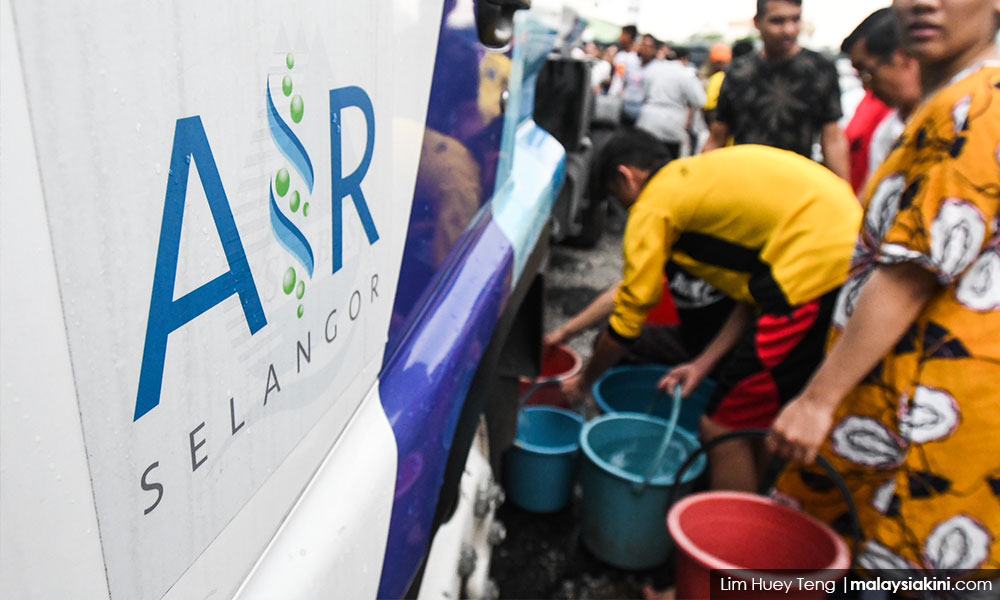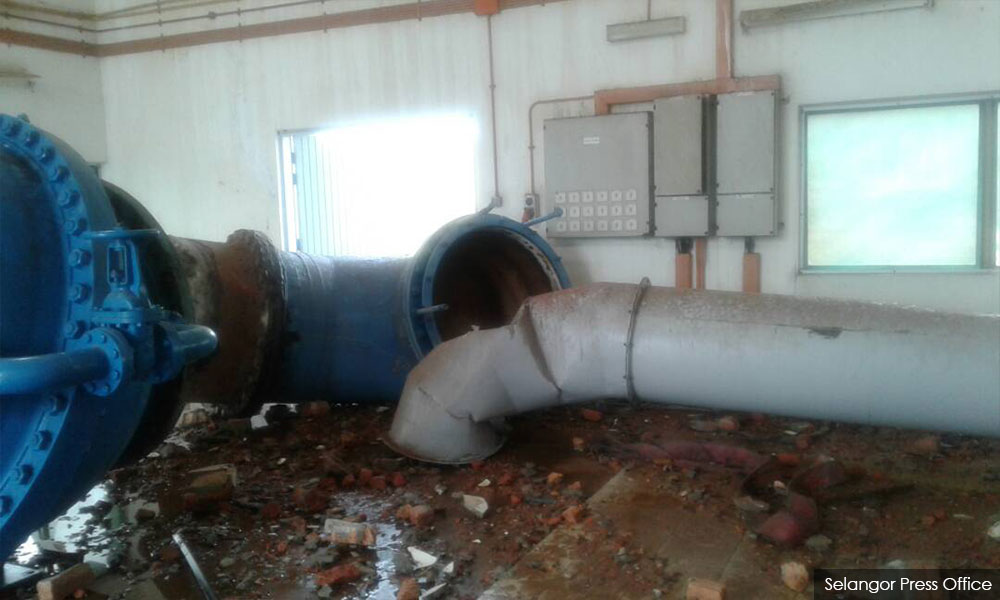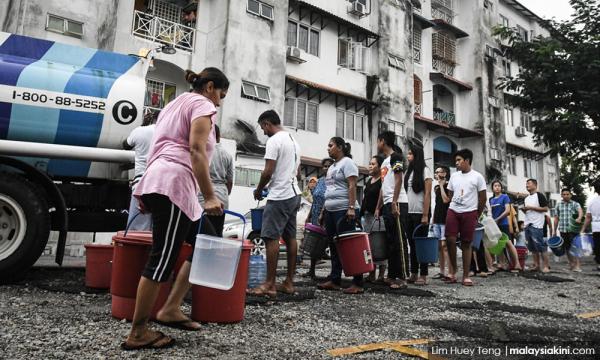COMMENT | Many theories and conclusions are being put forth about the water crisis in Selangor and Kuala Lumpur. But what actually caused it?
The low treated water reserve margin is the culprit behind this. The Association of Water and Energy Research (Awer) issued warnings about this scenario since 2011, but we were accused of being misleading, and even called “barua” and other such terms. But what we predicted is actually taking place.
The reserve margin is the extra distributable capacity after catering to current demand. The reserve margin will allow the treatment plant to cater to any sudden demand increase or unforeseen water shortage.
It is vital that there is sufficient reserve margin during scheduled (maintenance and pipe replacement) and unscheduled (low level of raw water, major pipe bursts, raw water pollution and sudden breakdowns) operation problems. The reserve margin assists in reducing impact at affected areas, as well as speeding up recovery after a disruption.
When the reserve margin is low, recovery after disruption will be longer, as the system needs to cater to filling up system's reservoirs, meet existing and backlogged demand, and accommodating for non-revenue water (NRW). The low reserve margin situation also causes low water pressure in some areas even during normal operation on hotter days.
There are two solutions to solve the low reserve margin. The first is building a new water treatment plant, and secondly to reduce NRW. Using cost benefit analysis, building a new water treatment plant is the immediate step. The reduction of NRW is a supporting solution, as high NRW is lost treated water.
But why did we reach this low reserve margin?

The Water Services Industry Act 2006 (WSIA) was enforced in 2008 by the Water Services Commission (Span). This requires the state government to adapt to the restructuring via the WSIA model.
Span is the regulator for water services, which include treatment, supply and sewerage. Liabilities from existing operation will be transferred to Pengurusan Aset Air Berhad (PAAB) via the restructuring process. PAAB is also regulated by Span. All new infrastructure will be funded via PAAB or other cheaper financing (if applicable). Changing old pipes and building new treatment plants will be made easier by this.
But the Selangor state government did not agree to restructure until the 2014 water crisis that kept 60 percent of Selangor, Kuala Lumpur and Putrajaya consumers on a water rationing plan for few months.
The Langat 2 Water Treatment Plant was scheduled to be completed by 2014, and has now been delayed to 2019. This plant will produce 1.13 million litres per day (MLD) of treated water, which would have added about a 20 percent reserve margin if it began operation in 2014.
From 2014 until today, many new projects and the expansion of existing projects have been put on hold. Only selected projects, on a case-to-case basis, are being approved. The reported demand increase is inaccurate, as it is being suppressed.
On the other hand, the NRW level in Klang Valley is still above 30 percent, and when Langat 2 is fully operational by 2019, the effective treated water that can be distributed will be around 790 MLD (after deducting conservative NRW levels).
We also need to keep in mind that when more water is available for supply, it will increase pressure in the pipe networks, which may cause higher NRW.
The reserve margin after Langat 2 is operational will be around 10 to 15 percent, depending on the NRW situation as well as demand increase. After Langat 2 operates, we expect a steep increase in demand, as many pending project applications will be approved swiftly. By 2021 or 2022, if NRW is still above 25 percent, we will reach a low reserve margin situation again.
To make Langat 2 ease demand increase beyond 2025, we need to tackle NRW with full force.
Is overloading a good practice?
Now we come back to the recent incident in the Sungai Selangor Phase 3 (SSP3) water treatment plant. This plant has been operating on overloading, or beyond its existing capacity, by 20 percent since 2016. Overloading requires the treatment and supply system to be upgraded to cater ot higher treated water output.

I remember questioning a senior Span official in a closed-door meeting in the Energy, Green Technology and Water Ministry in early 2016 regarding this.
Overloading will speed up wear and tear as well as increase the maintenance cost. The supporting systems needs to be upgraded to ensure there is no system failure. There is no way a scheduled maintenance can be postponed if a particular plant is operating under overloading situation.
Did Span, Kettha and the Selangor government make necessary engineering audits to see if the overloading is sustainable?
Just recently, it was reported that the manager of SSP3 plant mentioned a lack of funds and expertise to maintain their plant. This is an absurd and irresponsible reasoning given by a concession holder.
Syarikat Pengeluaran Air Selangor Sdn Bhd (Splash) also claimed that they objected to the overloading of their plant.
To ensure the facts are disclosed accurately, Awer urges Span to form an independent enquiry committee on the SSP3 issue. The terms of reference of the committee should include:
- The overloading approval process for SSP3 followed required engineering audits to prevent unscheduled equipment failure;
- The time duration between detection of equipment with problem and actions taken;
- Potential breach of concession agreement clauses that can allow state government to cancel the concession agreement; and
- Overview of other treatment plants that are overloaded in Klang Valley to prevent incidents like SSP3.
This committee must publish its findings and ensure the treated water supply security in Klang Valley is not disrupted.
Restructuring is a must
The Selangor government must swiftly conclude the restructuring process and follow through the 30-year business plan promptly. Further delays will only cause more water disruptions as well as higher cost to tariff.
To other states that are still delaying restructuring into WSIA model, Selangor has set a clear cut example of the negative repercussions on failure to restructure at the right time to allow infrastructure development and improvement.
Politicising water services will never bring any good to any entity. Just look at how Negeri Sembilan and Malacca have improved their water treatment and supply situation after restructuring.
Similarly, Kettha and Span should play a more proactive role, not the “wait and see” approach they are employing now. They always point fingers at others, though there are weaknesses and incompetency in their own operations.
If the need arises, incompetent officers should be removed to ensure the federal government is able to protect water services, which are crucial for the people and the economy.
S PIARAPAKARAN is the president of the Association of Water and Energy Research Malaysia.
The views expressed here are those of the author/contributor and do not necessarily represent the views of Malaysiakini.


